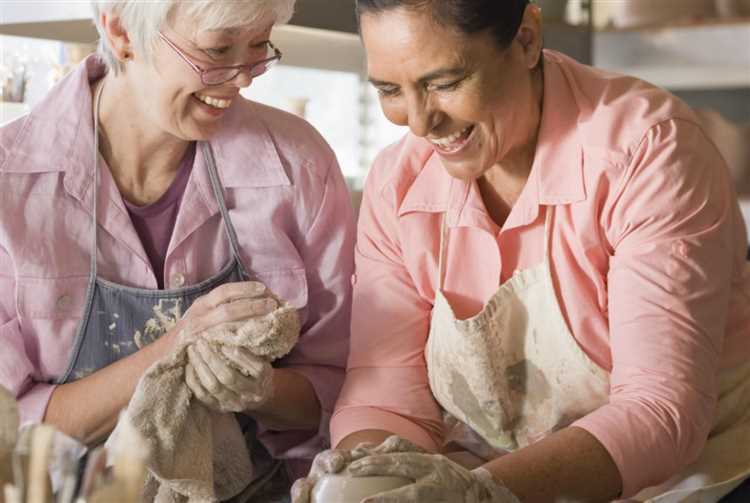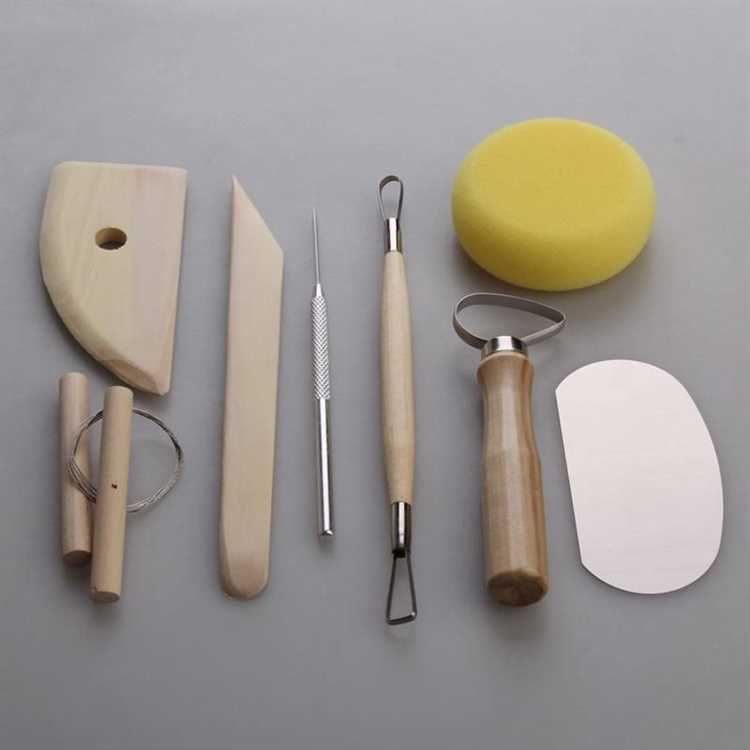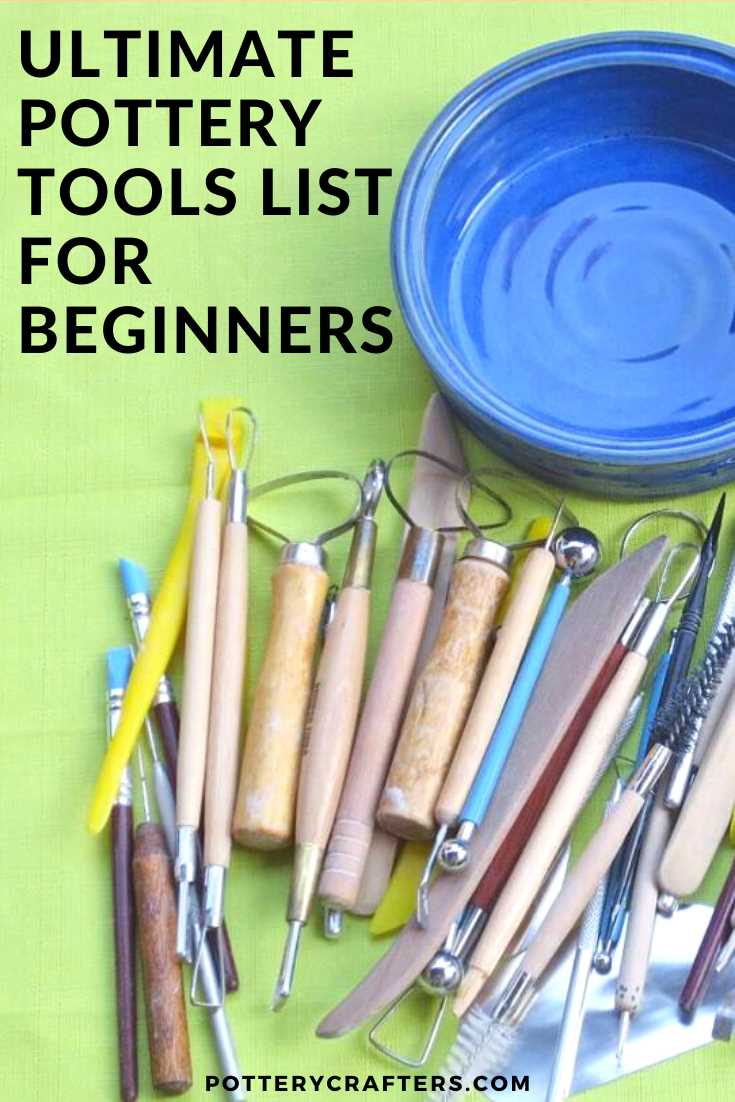Pottery is a craft that has been around for thousands of years. It is a form of art that involves shaping clay and other materials into various objects such as pots, vases, and sculptures. To create these beautiful pieces, potters use a variety of tools that help them mold, shape, and decorate the clay.
In this guide, we will take a look at the basic pottery tools and their uses. Whether you are a beginner or have some experience with pottery, having a good understanding of these tools is essential to creating successful pottery pieces. So, let’s dive in and explore the world of basic pottery tools!
1. Pottery Wheel: The pottery wheel is perhaps the most essential tool in a potter’s arsenal. It is a rotating device that allows potters to shape and form the clay into various shapes and sizes. With the help of the pottery wheel, potters can create symmetrical and well-balanced pieces with ease.
2. Clay Tools: Clay tools come in various forms and sizes and are used for shaping, trimming, and carving clay. Some commonly used clay tools include pottery ribs, wire clay cutters, modeling tools, and pottery needles. These tools help potters shape the clay and add intricate details to their pottery pieces.
3. Kiln: The kiln is an essential tool for firing pottery. It is a specialized oven that reaches high temperatures, allowing the clay to harden and become durable. Kilns come in different sizes and can be electric, gas, or wood-fired. The type of kiln used depends on the potter’s preference and the desired outcome of the pottery piece.
4. Glazes and Brushes: Glazes are colorants that add a decorative and protective layer to the pottery after it has been fired. Brushes are used to apply glazes to the pottery surface, allowing potters to achieve a desired look and feel. There are various types of glazes and brushes available, each creating different effects and finishes on the pottery.
These are just a few of the basic pottery tools that every potter should be familiar with. There are many other tools available that cater to specific pottery techniques and styles. As you continue to explore the world of pottery, you will discover new tools and techniques that will enhance your creativity and help you create unique and beautiful pottery pieces.
So, whether you are just starting out or have been pottery for years, having a good understanding of these basic pottery tools is essential. They are the building blocks that will enable you to create pottery pieces that are both functional and visually appealing. So, gather your tools and let your creativity flow!
Types of Pottery Tools
When it comes to pottery, there are several tools that are essential for creating and shaping clay. These tools come in various shapes, sizes, and materials, each serving a specific purpose. Here are some common types of pottery tools:
- Clay Cutters: These tools are used to cut clay into desired shapes and sizes. They come in various shapes, such as wires, blades, and cookie cutters.
- Potters’ Ribs: These are curved tools made of wood or metal. They are used to shape and smooth the surface of the clay by applying pressure and controlling the shape of the vessel.
- Modeling Tools: These tools have various-shaped tips and are used for carving, shaping, and adding fine details to the clay. They can be made of wood, metal, or plastic.
- Sponges: Sponges are used to add moisture to the clay surface, smooth it, and remove excess water during the pottery process. They come in different sizes and shapes, such as small rounded sponges or large flat sponges.
- Needle Tools: These tools have a sharp pointed tip and are used for trimming, scoring, and detailing the clay surface. They can also be used for piercing air bubbles or creating texture.
- Brushes: Different types of brushes are used in pottery for applying glazes, underglazes, or slips to the clay surface. They come in various sizes and materials, such as bristle or sponge brushes.
- Calipers: Calipers are used to measure the diameter and thickness of pottery pieces. They are typically adjustable and come in handy for creating vessels with consistent sizes.
- Wire Tools: Wire tools, such as cutting wires and wire loops, are used for cutting clay, slicing through pottery pieces, or creating clean edges.
These are just some of the basic pottery tools that every potter should have in their toolkit. Each tool has a specific function and can greatly impact the outcome of your pottery creations.
Clay Prep Tools
Before you start shaping your pottery, you need to prepare your clay. This involves several tools that will help you work with the clay effectively and efficiently. Here are some essential clay prep tools:
- Clay Wedge: A clay wedge is used to remove any air bubbles and homogenize the clay. It is done by pressing and rolling the clay repeatedly to create a smooth and uniform texture.
- Wire Cutter: A wire cutter is used to cut clay into manageable pieces. It is a thin wire stretched across a handle that can effortlessly slice through the clay.
- Clay Knife: A clay knife is used for trimming and cutting clay. It has a sharp edge that allows for precise shaping and trimming of clay surfaces.
- Clay Scraper: A clay scraper is a tool with a flat, metal blade used to remove excess clay from the pottery surface. It helps to smooth out any imperfections and create a clean finish.
These clay prep tools are essential for preparing your clay and ensuring that it is ready for shaping. With these tools, you can remove air bubbles, cut clay into manageable pieces, trim and shape the clay, and create a smooth finish on your pottery.
Shaping and Sculpting Tools
Shaping and sculpting tools are essential for creating intricate details and refining the shape of your pottery. These tools allow you to manipulate the clay and add texture and design elements to your work.
Here are some common shaping and sculpting tools used in pottery:
- Loop Tools: Loop tools are used for cutting, shaping, and removing clay. They have a looped wire or ribbon at the end that can be used to carve or smooth clay surfaces.
- Rib Tools: Rib tools are flat, curved tools used for shaping and smoothing clay. They come in different sizes and shapes and are great for creating smooth surfaces.
- Modeling Tools: Modeling tools are versatile tools used for shaping, sculpting, and detailing clay. They often have different-shaped tips, such as a pointed end, a rounded end, or a flat end, which allow for different design possibilities.
- Sponges: Sponges are used for smoothing and cleaning the clay surface. They can also be used to add water to the clay to make it more pliable and workable.
- Needle Tools: Needle tools have a sharp, pointed end and are used for fine detailing, piercing holes, and trimming excess clay.
When using shaping and sculpting tools, it’s important to work with care and precision. Experiment with different tools and techniques to create unique and interesting textures and shapes in your pottery.
Texturing and Detailing Tools
Texturing and detailing tools are essential for adding intricate patterns and designs to your pottery pieces. These tools allow you to create unique textures and details that can enhance the overall aesthetic of your work.
Here are some commonly used texturing and detailing tools:
- Texturing Ribs: These ribbed tools come in various shapes and sizes and are used to create different textures on the surface of the clay. They can be used to create smooth lines, ridges, or patterns.
- Sponges: Sponges are used to smooth and texture the surface of the clay. They can be used to create a variety of effects, from a smooth finish to a textured appearance.
- Sgraffito Tools: These tools have a pointed tip and are used for carving designs into the surface of the clay. They can be used to create intricate patterns and details.
- Stamps: Stamps are used to create raised patterns or designs on the surface of the clay. They come in various designs and can be used to add texture and detail to your pottery pieces.
- Paintbrushes: Paintbrushes are not only used for painting, but they can also be used for applying slip or underglaze to create detailed designs on the surface of the clay. They allow for precise application and can help you achieve intricate patterns and details.
When using texturing and detailing tools, it’s important to experiment and practice to find the techniques that work best for you. Don’t be afraid to take risks and try new things – this is what will help you develop your own unique style and create truly one-of-a-kind pottery pieces.
Trimming and Carving Tools
Trimming and carving tools are essential for giving your pottery a refined and polished finish. They allow you to shape and sculpt your clay with precision and add intricate details to your creations. Here are some commonly used trimming and carving tools:
- Trimming Tools: These tools are used to remove excess clay and refine the shape of your pottery. They usually have a sharp edge or looped wire that cuts through the clay smoothly. Trimming tools come in different shapes and sizes, such as loop tools, kidney-shaped tools, or metal rib tools.
- Carving Tools: Carving tools are used to create intricate designs and patterns on the surface of your pottery. They often have a sharp and pointed tip that allows for precise carving. Carving tools can be made of metal or plastic, and they come in various shapes, such as V-shaped, U-shaped, or square-shaped.
- Sponges: Sponges are not exactly trimming or carving tools, but they play an important role in the process. Sponges are used to moisten and smooth the clay surface, as well as to clean and refine the edges of your pottery. They come in different shapes and sizes, such as round sponges, flat sponges, or sponge sticks.
When using trimming and carving tools, it’s essential to be careful and precise. Start with lighter strokes and gradually increase the pressure as needed. Take your time and practice with different techniques to achieve the desired results. Remember to clean your tools after each use to prolong their lifespan and maintain their performance.
Overall, trimming and carving tools are invaluable for any potter looking to add detail and finesse to their creations. With these tools, you can enhance the beauty and craftsmanship of your pottery and take your skills to the next level.
Glazing and Decorating Tools
Glazing and decorating tools are essential for adding color and texture to your pottery pieces. There are various tools available for different glazing and decorating techniques. Here are some common tools used in pottery:
- Brushes: Brushes are a versatile tool used for applying glazes and paints onto the pottery surface. There are different types and sizes of brushes available, such as flat brushes for covering larger areas, and detail brushes for creating intricate designs.
- Sponges: Sponges are used for various techniques, such as applying glazes in a smooth and even manner, creating texture, and removing excess glaze. Different types of sponges, like sea sponges or synthetic sponges, can be used depending on the desired effect.
- Sgraffito Tools: Sgraffito is a technique where a design is scratched into the pottery surface. Sgraffito tools are used to create fine lines and details by scraping away layers of glaze or clay.
- Stamps and Texture Tools: Stamps and texture tools are used to create patterns and textures on the pottery surface. These tools can be made from wood, rubber, or other materials, and can create various designs like geometric patterns or nature-inspired textures.
- Sculpting Tools: Sculpting tools are used for shaping and carving clay before it is fired. These tools can create different textures and shapes, such as adding details to flower petals or shaping clay into intricate forms.
- Trimmers and Cutters: Trimmers and cutters are used for cutting and shaping pottery pieces. They can be used to remove excess clay, create clean edges, or trim the foot of a pot.
These are just a few examples of the many glazing and decorating tools available for potters. The specific tools you choose will depend on the techniques and effects you want to achieve in your pottery. Experimenting with different tools can help you discover new ways to enhance your ceramic creations.
Kiln Tools
Kiln tools are essential for the firing process in pottery. They help control the temperature and ensure that the pottery pieces are evenly heated and cooled. Here are some important kiln tools:
- Kiln Shelves: These are flat, fire-resistant platforms on which the pottery pieces are placed inside the kiln. They come in various sizes and can be made from materials like cordierite or silicon carbide.
- Kiln Posts: Kiln posts are used to create layers or shelves inside the kiln. They are cylindrical supports that keep the kiln shelves separated from each other, allowing for multiple layers of pottery to be fired at the same time.
- Kiln Furniture: Kiln furniture refers to all the accessories used in the kiln, including shelves, posts, and other supports. These items are designed to withstand high temperatures and provide a stable base for the pottery pieces during firing.
- Kiln Vent: A kiln vent is a device that helps remove harmful gases, smoke, and fumes from the kiln during firing. It improves air circulation and ensures a safe working environment by reducing the risk of inhaling toxic substances.
- Kiln Thermocouple: A thermocouple is a temperature-sensing device that measures the heat inside the kiln. It is connected to a controller, allowing the potter to monitor and regulate the temperature during the firing process.
These are just a few of the essential kiln tools used in pottery. Each tool plays a crucial role in achieving successful firings and ensuring the quality of the finished ceramic pieces.
Cleaning and Maintenance of Pottery Tools
Proper cleaning and maintenance of pottery tools is essential to ensure their longevity and effectiveness. Regular cleaning not only keeps your tools in good condition but also helps prevent contamination of your clay or glazes. Here are some tips on how to clean and maintain your pottery tools:
- Wipe off Excess Clay: After each use, wipe off any excess clay from your tools using a damp cloth or sponge. This will prevent the clay from hardening and becoming difficult to remove later.
- Wash with Mild Soap: Fill a bucket or sink with warm water and add a mild soap or dishwashing liquid. Submerge your tools in the soapy water and use a brush to gently scrub away any remaining clay. Rinse the tools thoroughly with clean water afterwards.
- Dry Completely: After washing, make sure to dry your tools thoroughly before storing them. Leaving them damp can lead to rust or mold growth. Use a clean towel or air dry them in a well-ventilated area.
- Oil Metal Tools: Metal pottery tools, such as wire cutters or loop tools, should be periodically oiled to prevent rust. Apply a thin layer of mineral oil or machine oil and wipe off any excess with a clean cloth.
- Sharpen Blades: If your pottery tools have cutting blades, such as trimming tools or knives, it’s important to keep them sharp for optimal performance. Use a sharpening stone or sandpaper to gently sharpen the blades as needed.
- Store Properly: To prevent damage, store your pottery tools in a clean and dry location. Use a tool holder, tool roll, or dedicated drawer to keep them organized and protected from dust or moisture.
By following these cleaning and maintenance practices, you can ensure that your pottery tools remain in good condition and continue to serve you well in your pottery projects.
FAQ:
What are the basic pottery tools?
The basic pottery tools include a throwing wheel, a kiln, clay, a kiln shelf, a kiln post, a sponge, a wire tool, a clay cutter, a rib tool, and a finishing tool.
How does a throwing wheel work?
A throwing wheel is a spinning platform that allows you to shape clay with your hands while it is spinning. This helps to create even shapes and smooth surfaces.
What is a kiln used for in pottery?
A kiln is a special oven used to fire clay creations. It reaches very high temperatures, allowing the clay to harden and become durable.
Can I use any type of clay for pottery?
No, there are different types of clay that are specifically formulated for pottery. The most common types include earthenware clay, stoneware clay, and porcelain clay.
What is the purpose of a rib tool in pottery?
A rib tool is used to smooth and shape clay. It can create clean lines, add texture, and refine the surface of your pottery.


